For the first time in the history of COP climate summits, the US – the world’s largest historical emitter – has not sent a delegation to the talks.
Back in January, newly inaugurated US president Donald Trump signed a letter to the UN to trigger the start of a US withdrawal from the Paris Agreement for a second time.
Although this process is not yet complete, the White House confirmed earlier this month that no “high-level officials” would be attending COP30 in Belém, Brazil.
The US joins Afghanistan, Myanmar and San Marino as the only countries not registering a delegation for the summit, according to Carbon Brief’s analysis of the provisional lists of delegates published by the United Nations Framework Convention on Climate Change (UNFCCC).
Despite these absences, more than 56,000 delegates have signed up to attend COP30 in person, provisionally placing the summit as one of the largest in COP history.
This is despite the run-up to the negotiations being dogged by reports of a shortage of beds and “sky-high” accommodation costs.
Brazil even offered free cabins on cruise ships moored in Belém to delegations from low-income nations who were otherwise unable to attend.
COP30 Insider Pass
A two-week, all-access package designed for those who need much more than headlines.
According to the provisional figures, 193 countries, plus the European Union, have registered a delegation for the summit.
Unsurprisingly, the largest delegation comes from COP30 hosts Brazil, with 3,805 people registered.
This is followed, in order, by China, Nigeria, Indonesia and the Democratic Republic of the Congo.
This year also sees the largest number of “virtual” delegates, with more than 5,000 people signed up to attend the talks online.
Party delegations
With 56,118 delegates registered, COP30 is provisionally the second-largest COP in history, behind only COP28 in Dubai, which was attended by more than 80,000 people.
This is the provisional total, based on the delegates that have registered to be at the summit in person. At recent COPs, the final total is at least 10,000 lower, which would drop COP30 down to the fourth largest.
(The UNFCCC releases the final figures – based on participants collecting a physical badge at the venue – after the summit has closed.)
The chart below shows how the provisional figures for COP30 compare to the final totals in past COPs – going back to COP1 in Berlin in 1995.

Overall totals for delegates from parties, observers and the media for all COPs, as published by the UNFCCC (see this article for more details on the data). Data for COPs 1-29 are the “final” figures, while COP30 data is “provisional”. Chart by Carbon Brief.
The participant lists provided by the UNFCCC are divided between the different types of groups and organisations attending the summit. The largest group at COP30 is for delegates representing parties. These are nation states, plus the European Union, that have ratified the convention and play a full part in negotiations.
This group adds up to 11,519 delegates – the fourth largest behind the past three COPs.
(In keeping with recent COPs, the UNFCCC has published spreadsheets that name every single person that has registered for the summit – excluding support staff. Previously, COPs have typically included thousands of “overflow” participants in which countries and UN agencies could nominate delegates without their names appearing on their official lists.)
For consistency with Carbon Brief’s analysis of previous COPs, the above chart includes overflow delegates as a single group. However, the participant lists do divide the overflow delegates between parties and observer groups. Including the overflow numbers approximately doubles the total for party representatives to 23,509.
US no-show
Overall, of the 198 parties to the UNFCCC, 194 have registered delegations for COP30.
The most notable absentee is the US, which has been present at every other COP in history – even throughout Donald Trump’s first presidency.
On average, the US sends a delegation of around 100 people, typically making it one of the larger groups at the talks.
The absent parties – Afghanistan, Myanmar and San Marino – have been more sporadic attendees at past COPs.
Despite reports of a “logistical nightmare” hosting a COP summit in the Amazon, there has been no drop-off in the number of countries registering delegations for COP30.
In addition to hotel rooms and rental properties in Belém, beds have been made available on cruise ships, in converted shipping containers and in motels that Reuters primly described as being typically “aimed at amorous couples”.
Reports suggested that many developing nations considered scaling back their presence at COP30, with smaller delegations or attendees only coming for a few days.
While the average party delegation size of 59 (excluding overflows) is lower than the previous two COPs, it is similar to the average in COP26 in Glasgow and COP27 in Sharm el-Sheikh.
The map and table below present the delegation size – split between party and overflow badges – for all the countries registered for COP30. The darker the shading, the more delegates that country has signed up. Use the search box to find the data for a specific party.
From Carbon Brief via this RSS feed

